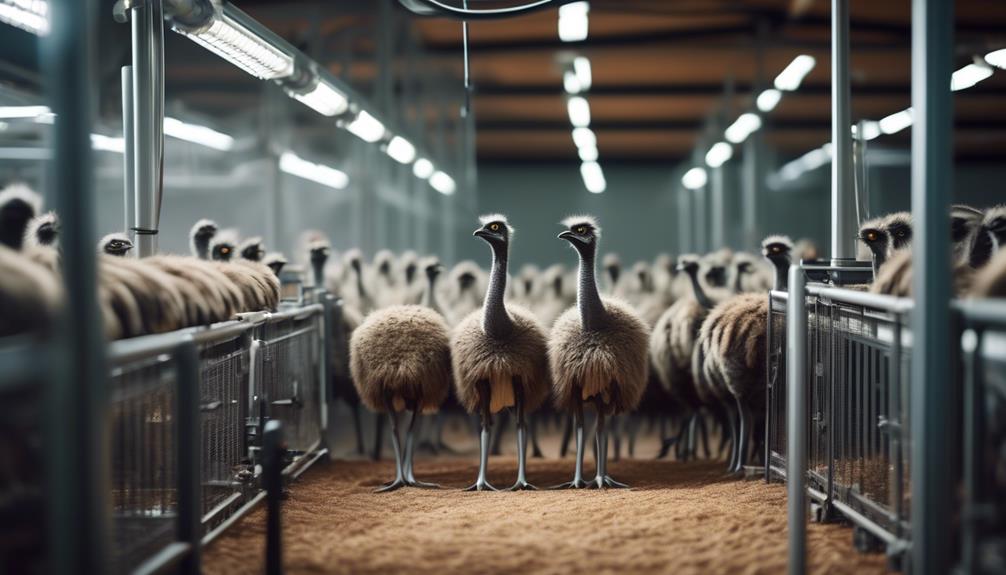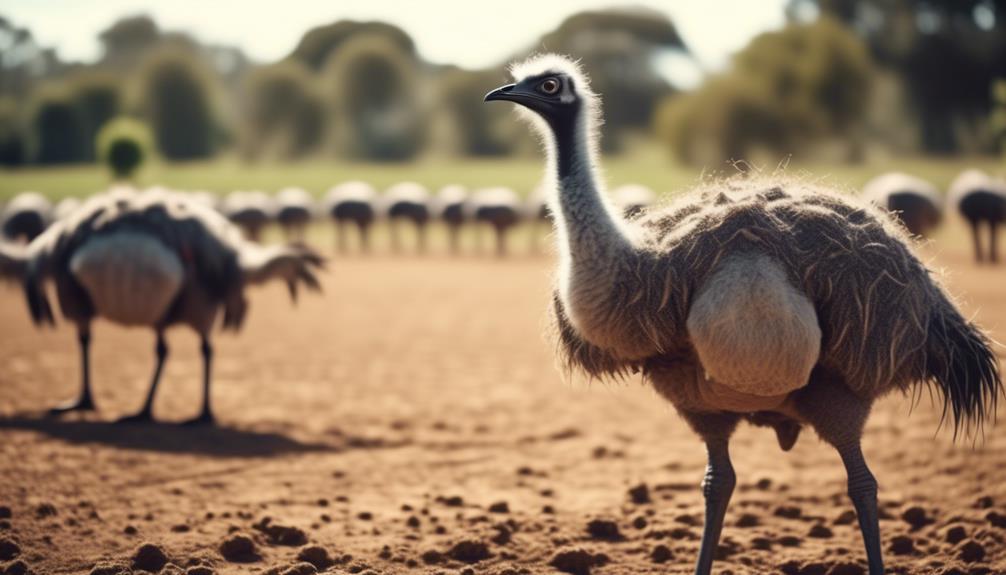
Imagine a world where emu farming is like a well-oiled machine, where technology and innovative techniques work seamlessly together to create a thriving industry.
Just as a conductor guides an orchestra to create harmonious melodies, these innovations in emu farming orchestrate a symphony of efficiency and productivity.
From automated feeding systems that ensure each emu receives the right amount of nutrition, to temperature-controlled environments that mimic their natural habitat, to genetic research that improves breeding outcomes, there is a wealth of advancements that are transforming the way emus are raised.
But what are these innovations, and how are they shaping the future of emu farming?
Automated Feeding Systems

Automated feeding systems are revolutionizing the way emu farmers provide nutrition to their livestock, increasing efficiency and ensuring optimal health and growth. These smart feeding systems, powered by the Internet of Things (IoT), have transformed traditional feeding practices into a seamless and precise process.
With smart feeding systems, emu farmers can monitor and control the feeding process remotely. Through the integration of sensors and data analytics, these systems collect real-time information about the emus' feeding patterns, consumption levels, and overall health. This data is then analyzed to provide valuable insights and make informed decisions regarding the feed composition and quantity.
IoT in feeding has enabled the automation of feeding schedules, ensuring that emus receive their required nutritional intake at the right time. These systems can also adapt to individual emus' needs, as they can track specific dietary preferences and adjust the feed accordingly. This personalized approach not only optimizes the emus' health and growth but also reduces feed wastage and associated costs.
Moreover, smart feeding systems can detect anomalies or deviations in the emus' eating patterns, signaling potential health issues such as illnesses or lack of appetite. By promptly identifying these issues, farmers can take immediate action, preventing further complications and ensuring the overall well-being of their emus.
Temperature-Controlled Environments
Once the emus' nutritional needs are efficiently met, the focus shifts to creating temperature-controlled environments that ensure their well-being and promote optimal growth. Emus are highly sensitive to temperature fluctuations, making it crucial to provide them with a comfortable and consistent climate throughout the year. This can be achieved through the use of smart climate control systems and energy-efficient technologies.
Smart climate control systems monitor and regulate the temperature, humidity, and ventilation in the emu farming facilities. These systems use sensors and advanced algorithms to maintain precise environmental conditions, ensuring that the emus are not exposed to extreme temperatures. By constantly monitoring the climate, farmers can make adjustments to optimize the conditions for the emus' well-being.
In addition to smart climate control, energy-efficient systems play a vital role in maintaining temperature-controlled environments. These systems are designed to minimize energy consumption while effectively controlling the temperature. By using energy-efficient technologies, farmers can reduce their carbon footprint and operating costs, making emu farming more sustainable.
The following table highlights some of the key features and benefits of smart climate control and energy-efficient systems in emu farming:
| Features | Benefits |
|---|---|
| Smart climate control | Consistent and comfortable climate for emus |
| Energy-efficient | Reduced energy consumption and lower operating costs |
| Precise monitoring | Real-time data on temperature, humidity, and ventilation |
| Optimal growth | Promotes healthy development and optimal growth of emus |
| Sustainable farming | Reduces carbon footprint and supports environmentally friendly practices |
Genetic Research and Improved Breeding

To enhance the quality and characteristics of emus, genetic research and improved breeding techniques are being employed in the field of emu farming.
Genome sequencing, a cutting-edge technology, has revolutionized the way emu breeders understand the genetic makeup of these fascinating birds. By decoding the emu genome, scientists have gained valuable insights into the genes responsible for desirable traits such as fast growth, disease resistance, and high-quality meat production.
With this newfound knowledge, selective breeding techniques are being implemented to optimize the genetic potential of emus. Breeders carefully choose parent birds with desirable traits and mate them to produce offspring with improved characteristics. This process involves analyzing the genetic information of individual emus and selecting those with the most favorable traits for breeding. By selectively breeding emus with superior attributes, such as larger size or better feather quality, farmers can gradually improve the overall quality of their emu flocks.
In addition to selective breeding, genetic research has also paved the way for more advanced techniques such as artificial insemination and embryo transfer. These methods allow breeders to manipulate the genetics of emus more precisely, leading to faster progress in improving desirable traits.
Through the integration of genome sequencing and selective breeding techniques, emu farmers can enhance the genetic potential of their flocks, resulting in emus with improved characteristics and overall quality. This approach ensures that the emu farming industry continues to evolve and meet the demands of consumers who seek high-quality emu products.
Enhanced Disease Management Techniques
Enhanced disease management techniques play a vital role in ensuring the health and well-being of emus in the farming industry. To effectively manage diseases in emu farms, it's important to implement various biosecurity measures.
These measures include:
- Strict quarantine protocols: Isolating new emus from the existing flock and monitoring their health can prevent the introduction and spread of diseases. Regular health checks and screenings should be conducted to detect any potential infections early on.
- Sanitation and hygiene practices: Maintaining clean and sanitized facilities, including regular disinfection of equipment and enclosures, can minimize the risk of disease transmission. Proper waste management is also crucial to prevent the accumulation of pathogens.
- Vaccination and alternative treatment methods: Vaccination programs tailored to emus can help prevent the occurrence of certain diseases. Additionally, alternative treatment methods, such as herbal remedies and homeopathy, can be explored to complement traditional veterinary treatments.
Implementing these disease management techniques can significantly reduce the incidence of diseases in emu farms, promoting the overall well-being of the flock. By prioritizing biosecurity measures, emu farmers can create a healthy environment for their birds and minimize the economic losses associated with disease outbreaks.
Precision Farming Tools and Software

Precision farming tools and software are essential for optimizing productivity and efficiency in emu farming operations. By incorporating IoT integration and remote monitoring, these tools and software enable farmers to have real-time access to critical data, allowing them to make informed decisions and take timely actions.
One of the key aspects of precision farming tools is IoT integration. This technology allows different devices and sensors to communicate and exchange data seamlessly. By connecting various elements of the emu farming operation, such as temperature monitors, feed dispensers, and water supply systems, farmers can monitor and control these aspects remotely. This integration enables them to ensure optimal conditions for the emus, leading to improved animal welfare and productivity.
Remote monitoring is another crucial feature of precision farming tools and software. With remote monitoring, farmers can keep track of various parameters such as environmental conditions, feed consumption, and water levels. By continuously monitoring these factors, farmers can identify trends, detect anomalies, and take necessary actions promptly. For example, if there's a sudden drop in water levels, the system can alert the farmer, enabling them to address the issue before it affects the emus' health.
Sustainable Farming Practices
By implementing sustainable farming practices, emu farmers can further optimize productivity and efficiency in their operations while minimizing the environmental impact. Emu farming has seen significant advancements in recent years, with the adoption of innovative techniques such as vertical farming and regenerative agriculture. These practices not only ensure the well-being of the emus but also contribute to the overall sustainability of the farm.
Here are three sustainable farming practices that emu farmers can implement:
- Vertical Farming:
- This method involves growing emu feed, such as grasses and grains, in vertically stacked layers.
- By utilizing vertical space, farmers can maximize land use efficiency and reduce the amount of land required for cultivation.
- Vertical farming also minimizes water usage and allows for year-round production, ensuring a consistent supply of nutritious feed for the emus.
- Regenerative Agriculture:
- This practice focuses on improving soil health and biodiversity while reducing chemical inputs.
- Emu farmers can implement regenerative agriculture techniques such as cover cropping, crop rotation, and organic fertilization.
- These methods enhance soil fertility, promote natural pest control, and increase carbon sequestration, contributing to a healthier and more sustainable farming ecosystem.
- Efficient Water Management:
- Emu farmers can implement water-saving technologies such as drip irrigation and rainwater harvesting systems.
- These systems optimize water usage by delivering water directly to the roots, minimizing wastage.
- Efficient water management not only conserves this precious resource but also reduces farm operating costs.
Frequently Asked Questions
How Much Does It Cost to Set up an Automated Feeding System for Emu Farming?
Setting up an automated feeding system for emu farming can be costly. The cost depends on various factors such as the size of the farm, the type of technology used, and the specific requirements of the emu feeding technology.
Can Temperature-Controlled Environments Be Beneficial for Other Livestock Farming Practices as Well?
Temperature-controlled environments can be highly beneficial in livestock farming. By providing optimal conditions for poultry farming, such as regulated temperatures and automated feeding systems, it improves animal welfare, productivity, and overall profitability.
What Specific Genetic Research Has Been Conducted to Improve the Breeding of Emus?
To improve emu breeding, specific genetic research has been conducted. This research aims to enhance traits such as egg production and meat quality. Additionally, temperature-controlled environments have shown positive impacts on emu farming, promoting optimal conditions for breeding and growth.
Are There Any Specific Disease Management Techniques That Have Been Found to Be Particularly Effective in Emu Farming?
To effectively manage diseases in emu farming, you'll need to focus on disease prevention and implement biosecurity measures. These techniques have been found to be particularly effective in minimizing the risk of disease outbreaks and ensuring the health of your emus.
Can Precision Farming Tools and Software Be Used to Monitor and Optimize Emu Farming Practices in Real-Time?
Yes, precision farming tools and software can be utilized to monitor and optimize emu farming practices in real-time. This technology allows for precise data collection and analysis, leading to more efficient and effective farming techniques.
Conclusion
In conclusion, the innovations in emu farming have revolutionized the industry, making it more efficient and sustainable.
One notable example is the use of automated feeding systems, which have significantly reduced labor costs and improved feed efficiency.
With this technology, farmers can accurately regulate the emus' nutrition, resulting in healthier and faster-growing birds.
Emu farmers who've implemented this system have reported a 20% increase in growth rates and a 30% decrease in feed wastage, leading to higher profits and a more sustainable future for the industry.


